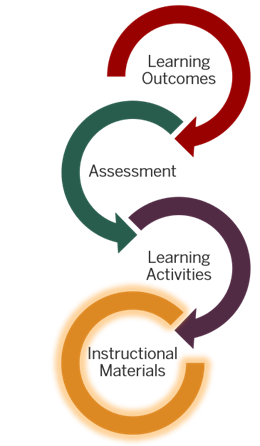Part 5: Online Instructional Materials
Identifying and Evaluating Instructional Materials

Continuing with the backward design approach, once you have your outcomes and the assignments you’ll use to assess those outcomes, you then need to look at the instructional materials you’re providing your students to help them successfully complete your assignments. You may already have some of your materials identified such as textbooks, other books, articles, or online publisher materials or digital learning tools.
As you put together your instructional materials, if you’re gathering materials that were not created by you or by the publisher of a text that your students have purchased, you should always verify the use and attribution requirements for those materials.
Evaluation Criteria
As you evaluate instructional materials, the first things you normally consider are
- is it accurate?
- is it relevant? (Does it provide information that students need to complete your assignment?)
- is it understandable? (Is it at a level appropriate to your student’s current understanding of the topic or concept?)
When evaluating instructional materials, consider the extent to which each is interesting, approachable, and engaging. This isn’t about materials being “entertaining.” It’s about whether it can spark curiosity and promote deeper thinking about the content. The more engaged students are with the materials you provide for learning, the more they’ll learn. To encourage engagement it is helpful to include a variety of types of materials in addition to text such as images, charts, diagrams, audio, video, or interactive activities. When you provide more than one way to learn something, it’s more likely learners will find a way that engages them and helps them learn. Universal Design for Learning (UDL) offers a robust framework for thinking about multiple means of representation as well as multiple means of expression and action.
There are some specific things to look for in both text and video materials that can increase the potential for engagement.
Text-based Materials

As you look at text-based materials, there are a few things to consider.
- Are instructional materials with a teaching purpose (so not journal articles, primary sources, etc.) written in a friendly and conversational tone?
- Are materials written at an appropriate reading level for your students? Realize that this will be lower than your reading level so what sounds fine to you may leave your students struggling. If you aren’t sure, you can run part of it through a Readability Checker.
- Are documents clear and easy to read? If it’s a scanned document, is the quality of the scan good enough that it can be easily read? If it’s skewed, blurry, or grainy it’s best to go through the library and get a better version. If it’s an article, it may be available through your library’s full-text databases.
- Are documents accessible? If it’s a scanned PDF, even if it clear and easy to read, it’s important to check if it is really text or literally a photograph of the page? If you click on the page and it turns blue, it’s a photograph. See Accessible PDF Files in the Canvas Semester Checklist for instructions on how to fix this as well as how to rotate pages so students aren’t tilting their heads sideways to read.
You’ll also want to identify things in the material that need your explanation or commentary. If you normally talk through a resource in class, you’ll need to provide that scaffolding to your students online through annotations, narrations, or other means.
Video Materials
Part of evaluating video materials is determining how much and what sort of video would be useful for your students. Here we are talking primarily about video that others have made. We’ll look more specifically at video that you make later in this module.
If you want your students to be able to do something that someone can demonstrate, then video would be a very good option. If your content involves specific places or cultures, video can help to make them real to your students in ways that pictures and words on a page cannot. If parts of your content are especially challenging to your students, walking through these rough points with diagrams or a virtual whiteboard can provide clarification. If your students have difficulty engaging with the content, videos can offer a more approachable way in.
Good places to start to look for videos are
- the Kanopy Video Streaming Service through the IU Indianapolis library which has a wide selection of titles that you can link to directly from your Canvas page. You can check for similar services through your library if you are affiliated with a different campus.
- Kahn Academy
- various Crash Course series available on YouTube
While not technically video, the Smithsonian Institute’s Smithsonian X 3D Explorer offers a collection of artifacts and tours that are interactive and, as the name suggests, 3-dimensional.
Considerations for Video
- How well does the video align with your class? Is it something that will directly help students reach a learning outcome or is interesting but not directly applicable?
- Is it at the right level for your students? Do they have the prerequisite background knowledge to get out what you want them to get out of it? Students will tune out if they don’t understand what the speaker is talking about—especially if the video uses jargon, acronyms, and other technical terms the student doesn’t know.
- How long is the video? Research shows that people’s attention begins to wander after a few minutes. Do your students really need to watch all of the video or only part of it? Identify that part and crop the video or give them the beginning and ending times.
- Does the video keep your attention? If you dozed or multitasked while the video was playing, the odds are good your students will do the same.
As an example of an engaging video you might pull into your course, here is one created by IU Media Arts and Sciences lecturer Mathew A. Powers in collaboration with both author John Green and his production company and School of Informatics alumni on the history of games. The video is part of a larger series stemming from his History of Video Games course.
Universal Design for Learning (UDL) is a set of principles for curriculum development that give all individuals equal opportunities to learn. UDL provides a blueprint for creating instructional goals, methods, materials, and assessments that work for everyone--not a single, one-size-fits-all solution but rather flexible approaches that can be customized and adjusted for individual needs.

